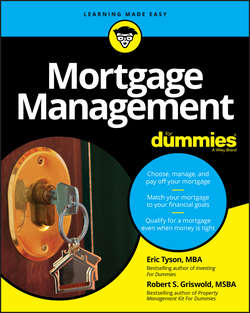Читать книгу Mortgage Management For Dummies - Tyson MBA Eric - Страница 6
На сайте Литреса книга снята с продажи.
Part 1
Getting Started with Mortgages
Chapter 1
Determining Your Borrowing Power
Only You Can Determine the Mortgage Debt You Can Afford
ОглавлениеSit down and talk in person or by phone, or use a website to gather information and then meet face to face with a reputable mortgage lender, and you’ll be asked about your income and debts. Assuming that you have a good credit history and an adequate cash down payment, the lender can quickly estimate the amount of mortgage debt you can obtain.
Suppose a mortgage lender says that you qualify to borrow, for example, $200,000. In this case, the lender is basically telling you that, based on the assessment of your financial situation, $200,000 is the maximum amount that this lender thinks you can borrow on a mortgage before putting yourself at significantly increased risk of default. Don’t assume that the lender is saying that you can afford to carry that much mortgage debt given your other financial goals.
Your overall personal financial situation – most of which lenders, mortgage brokers, and real estate agents won’t inquire into or care about – should help you decide how much you borrow. For example, have you considered and planned for your retirement goals? Do you know how much you’re spending per month now and how much slack, if any, you have for additional housing expenses, including a larger mortgage? How much of a reserve or rainy day savings fund do you have? How are you going to pay for college expenses for your kids? Are you or will you soon be helping to care for elderly relatives?
In the following sections, we start you on the path to answering these questions.
Acknowledge your need to save
Unless you have generous parents, grandparents, or in-laws, if you want to buy a home, you need to save money. The same may be true if you desire to trade up to a more costly property. In either case, you can find yourself taking on more mortgage debt than you ever dreamed possible.
After you trade up or buy your first home, your total monthly housing expenditures and housing-related spending (such as furnishings, insurance, and utilities) will surely increase. So be forewarned that if you had trouble saving before the purchase, your finances are truly going to be squeezed after the purchase. This pinch will further handicap your ability to accomplish other important financial goals, such as saving for retirement, starting your own business, or helping to pay for your own or your children’s college education.
Because you can’t manage the unknown, the first step in assessing your ability to afford a given mortgage amount is to collect data about your monthly spending (see the following section). If you already track such data – whether by pencil and paper or on your computer – you have a head start. But don’t think you’re finished. Having your spending data is only half the battle. You also need to know how to analyze your spending data (which we explain how to do in this chapter) to help decide how much you can afford to borrow comfortably.
Collect your spending data
What could be more dreadful than sitting at home on a beautiful sunny day – or staying in at night while your friends and family are out on the town – and cozying up to your calculator, banking and credit card transactions, pay stubs, and most recent tax return?
Examining where and how much you spend on various items is almost no one’s definition of a good time (except, perhaps, for some accountants, IRS agents, actuaries, and other bean counters who crunch numbers for a living). However, if you don’t endure some pain and agony now, you could end up suffering long-term pain and agony when you get in over your head with a mortgage you can’t afford.
Now some good news: You don’t need to detail to the penny where your money goes. That simply isn’t realistic. What you’re interested in here is capturing the bulk of your expenditures and allowing for some margin for unanticipated expenses, plus savings for an emergency fund. Ideally, you should collect spending data for a three- to six-month period to determine how much you spend in a typical month on taxes, clothing, transportation, entertainment, meals out, and so forth. If your expenditures fluctuate greatly throughout the year, you may need to examine a full 12 months of your spending to get an accurate monthly average. You also want to include any known changes in upcoming expenses. Maybe your child will be starting preschool next year at a private institution or your car is getting old and you know you’ll soon want to get a new vehicle.
Later in this chapter, we provide a handy table that you can use to categorize and add up all your spending. First, however, we need to talk you through the specific and often large expenses of owning a home so you can intelligently plug those numbers into your current budget.
